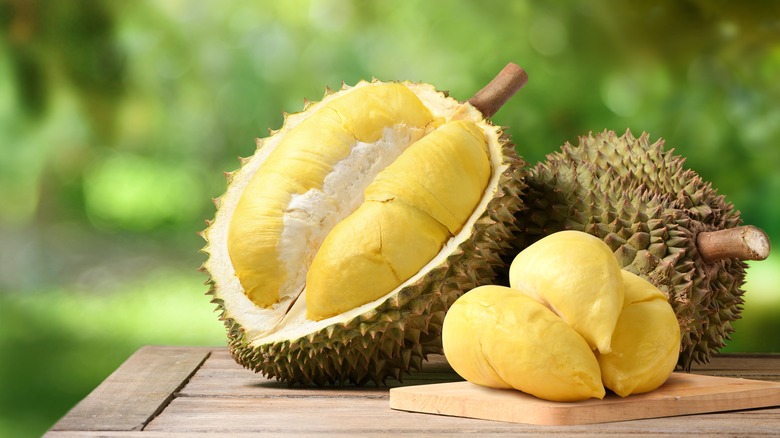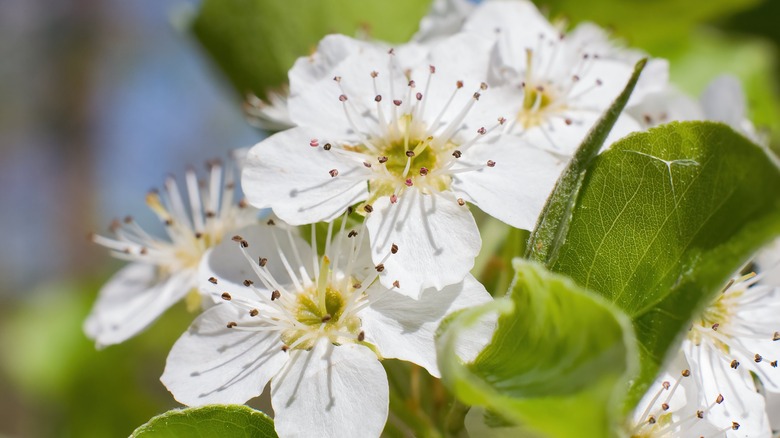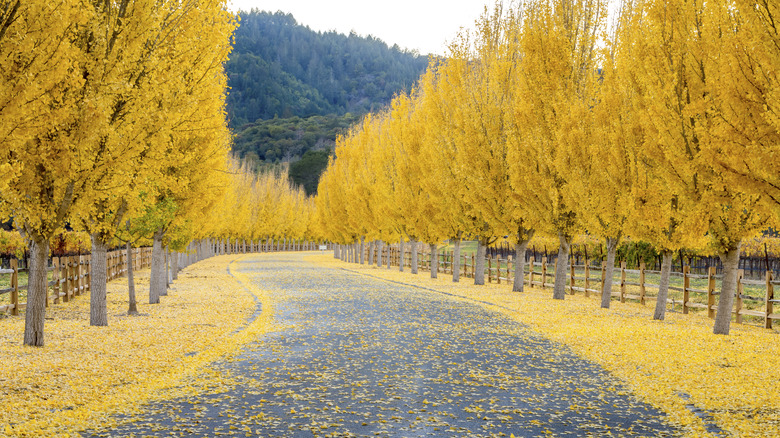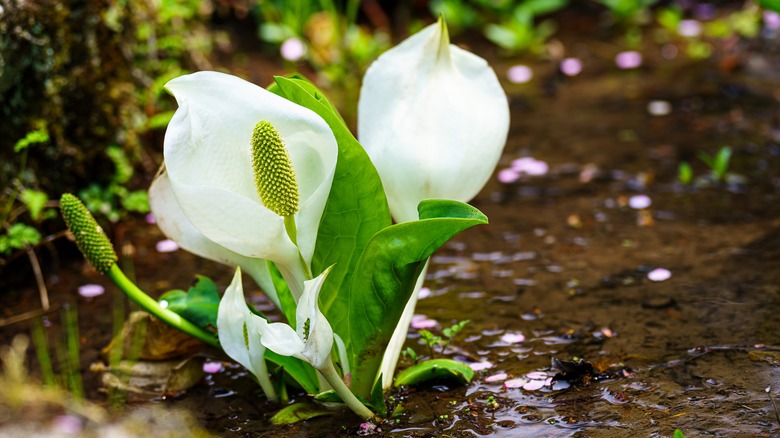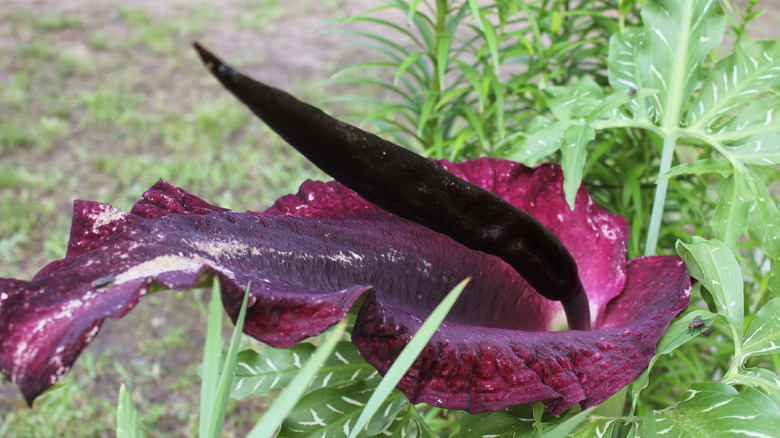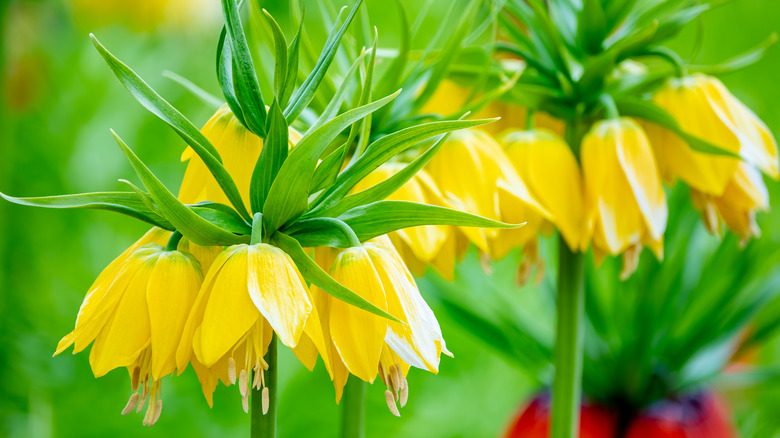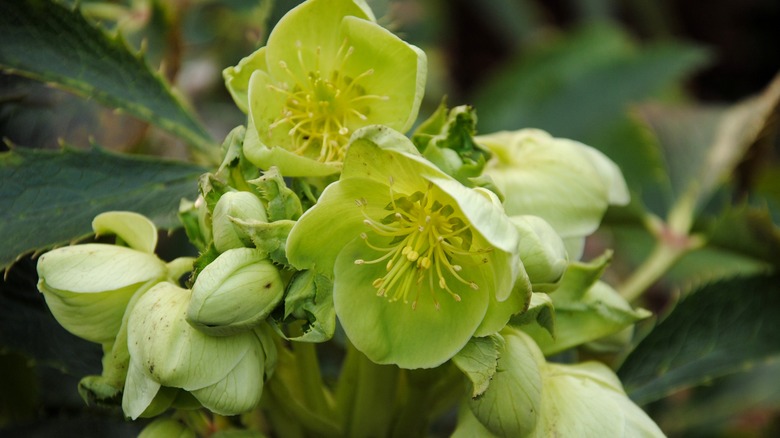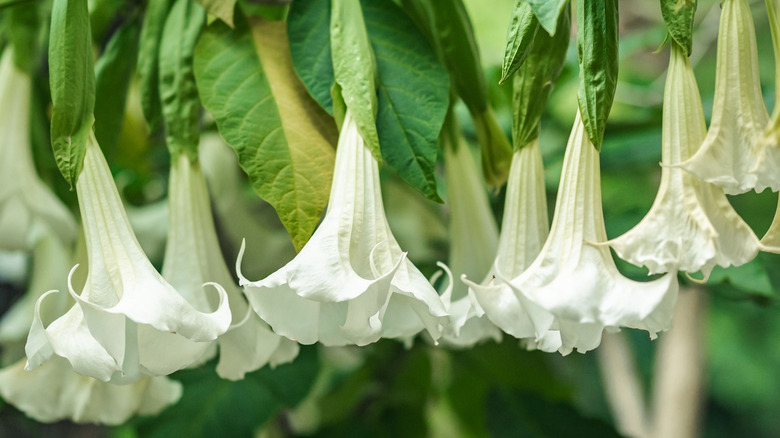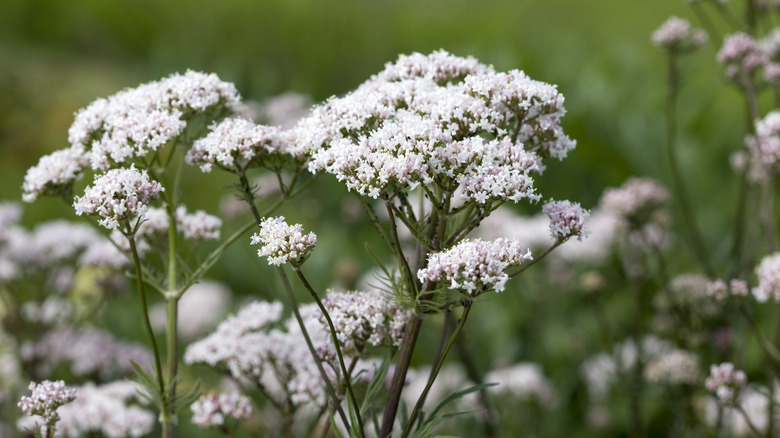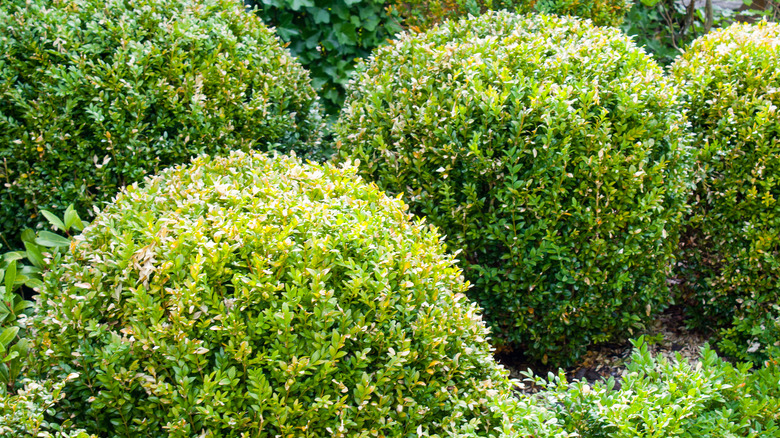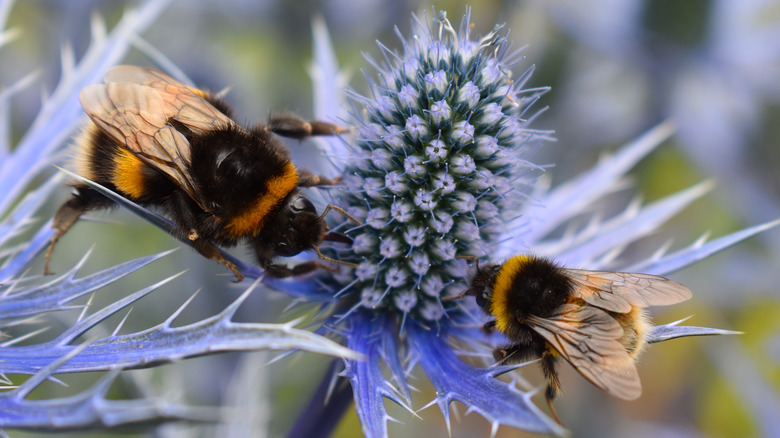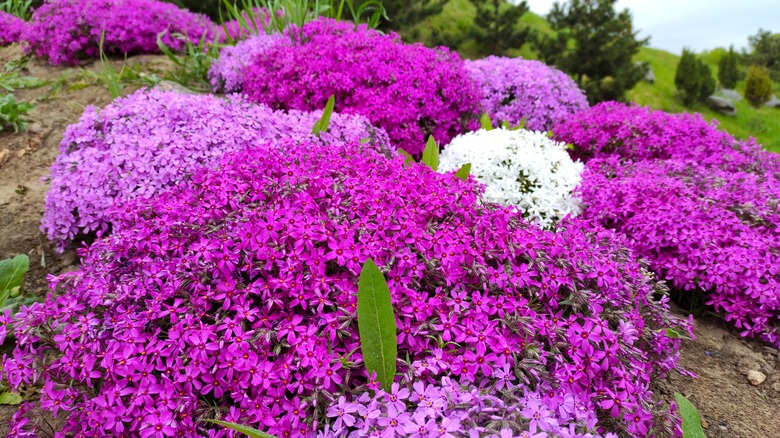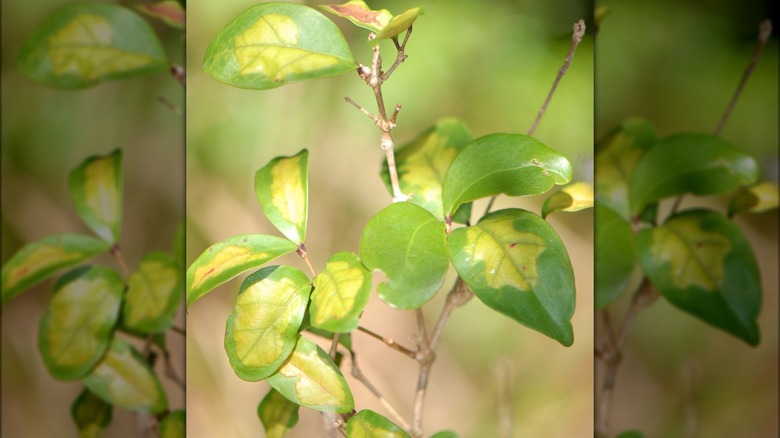If Your Garden Stinks, These Plants Might Be The Reason
Picture yourself on a tranquil summer evening, enveloped by the melody of chirping birds and the gentle sway of leaves in the breeze ... only to be interrupted by an unwelcome scent permeating the air, disrupting the tranquility of your cherished garden sanctuary. While gardens are often associated with the delightful aroma of blooming flowers and the freshness of nature, the truth is that certain plants can introduce less-than-pleasant olfactory experiences. From the earthy tang of sea holly to the pungent, ammonia-like odor of English boxwood, there are flora in our gardens that have garnered notoriety for emitting odors ranging from mildly disagreeable to downright offensive.
If you've ever found yourself wondering why your garden doesn't smell as sweet as you'd like, this is the article for you. Read on to discover which plants you might want to think twice about before growing them near your house, and learn valuable tips on rejuvenating your outdoor oasis into a fragrant paradise.
Bradford pear (Pyrus calleryana 'Bradford')
The Bradford pear (Pyrus calleryana 'Bradford') is a popular ornamental tree, prized for its stunning display of white flowers in the spring and vibrant fall foliage. Despite its aesthetic appeal, the Bradford pear is notorious for producing a foul smell, often likened to the scent of rotting fish or chlorine. This unpleasant odor emanates from its flowers, particularly when they are in full bloom during the early spring months.
The foul smell emitted by the Bradford pear tree is primarily caused by chemical compounds known as amines, which are released from the flowers. While the smell can be distinctly strong when the tree is in bloom, it tends to dissipate as the flowers fade and the tree enters the summer months.
Managing the odor produced by Bradford pear trees can be challenging, as it is a natural characteristic of the species. However, there are some strategies that homeowners and landscapers can employ to minimize its impact. One approach is to plant alternative tree species that offer similar visual appeal without the unpleasant smell, like the Serviceberry tree. Additionally, regular pruning and maintenance can help to reduce the number of flowers produced by the tree, thereby minimizing the odor. However, it's important to note that maintenance methods may only provide partial relief, as the odor is inherent to the species and cannot be entirely eliminated.
Gingko (Gingko biloba)
The Ginkgo biloba, commonly known as the Ginkgo or Maidenhair tree, is a unique and ancient species revered for its distinctive fan-shaped leaves and remarkable resilience in urban environments. They can withstand pollution, compacted soil, and fluctuating temperatures, making them well-suited for planting in urban areas where space is limited and environmental stressors are common. Despite its lively golden-yellow color, the female Ginkgo tree is notorious for emitting a strong and unpleasant odor from its fruit, especially in the Fall, when the fruit starts to drop. This odor is often described as reminiscent of vomit or rancid butter, which can be quite off-putting to those in close proximity.
The unpleasant odor emitted by female Ginkgo trees is primarily caused by butanoic and hexanoic acids, compounds found in the fruit. When the seeds of the fruit start to decay, the odor is particularly pungent.
Managing the odor produced by female Ginkgo trees can be challenging, as it is a natural characteristic of the species. However, there are some strategies that can help mitigate its impact. For example, planting male Ginkgo trees instead of females can eliminate the issue altogether, as male trees do not produce fruit. Alternatively, selecting cultivars that are known to produce fewer fruits or have less pungent odors can also help minimize the problem.
Skunk cabbage (Symplocarpus foetidus)
Skunk Cabbage (Symplocarpus foetidus) is a fascinating plant known for its distinctive foliage and its pungent odor, which resembles that of a skunk's spray. This foul smell is especially noticeable when the plant's leaves are bruised or crushed.
Despite its odoriferous reputation, some gardeners choose to plant skunk cabbage for its ornamental foliage. The plant's large, glossy leaves emerge in early spring, often before many other plants have begun to grow, making it a welcome sight in gardens and natural areas. The leaves can reach impressive sizes, sometimes measuring over a foot in length, and their bold green color adds a striking contrast to the landscape. Skunk cabbage is also well-adapted to wetland habitats, where it plays an important ecological role in filtering water and providing habitat for various wildlife species. Its ability to grow in soggy, waterlogged soils makes it a valuable addition to rain gardens, pond margins, and other wetland restoration projects.
The foul odor emitted by skunk cabbage is primarily caused by sulfur-containing compounds, a study in the Journal of Natural Products found, which are released when the plant's cells are damaged. These compounds not only deter herbivores but also attract certain pollinators, such as scavenging flies, which are drawn to the smell of rotting flesh.
Voodoo lily (Dracunculus vulgaris)
Despite the unpleasant odor emitted by the voodoo lily (Dracunculus vulgaris), gardeners often plant it for its striking appearance and exotic appeal. The plant's large, deeply lobed leaves and dramatic, dark purple spathe make it a striking addition to gardens and landscapes. When in bloom, the voodoo lily produces a tall inflorescence topped with the spathe, which surrounds a central spike-like structure known as the spadix. The combination of its unusual foliage and distinctive flowers gives the voodoo lily an air of mystery and allure that appeals to many gardeners and plant enthusiasts.
The foul odor emitted by the voodoo lily is most potent when the flower blooms, as this is when it is seeking to attract pollinating flies. The scent, which is often described as similar to rotting meat or carrion, is produced by chemical compounds that mimic the smell of decaying flesh, tricking flies into visiting the flower and inadvertently aiding in its pollination process.
Despite its olfactory drawbacks, the voodoo lily is a resilient and adaptable plant that can thrive in a variety of conditions. It is relatively low-maintenance and can tolerate a wide range of soil types and moisture levels, making it well-suited for cultivation in gardens and landscapes.
Crown Imperial (Fritillaria imperialis)
The crown imperial (Fritillaria imperialis) is a striking and majestic plant known for its tall stature and vibrant orange or yellow flowers. Despite its aesthetic appeal, the crown imperial is notorious for emitting a strong and unpleasant odor, often likened to the scent of a skunk or garlic. Despite the malodorous nature of its scent, people continue to plant crown imperials for several reasons. Firstly, the plant's tall, erect stems and large, bell-shaped flowers make a bold statement in the garden, adding height and color to borders and beds. The flowers, which hang downward from the top of the stem, create a dramatic effect and are highly attractive to pollinators such as bees and butterflies.
Additionally, crown imperials are relatively low-maintenance and easy to grow, making them a popular choice for gardeners seeking to add a touch of drama and elegance to their outdoor spaces. They tolerate a wide range of soil types and can thrive in full sun to partial shade, making them adaptable to various garden conditions.
The unpleasant odor emitted by crown imperials is released from the plant's flowers and foliage in order to deter pests from the plant. These compounds give the plant its distinctive smell, which can be quite strong and overpowering, especially on warm days when the scent is more likely to be carried on the breeze.
Hellebore (Helleborus spp.)
Hellebores, belonging to the genus Helleborus, are beloved by gardeners for their early bloom time. They are one of many plants that have a long lifespan, and they are known to thrive in shady areas. Their flowers come in a range of colors, including white, pink, purple, and green, adding diversity and interest to garden beds and borders.
The skunky or musty odor emitted by some species of hellebore is primarily noticeable when the leaves or stems are crushed or torn, which has given it the name "stinking hellebore." While some find the odor off-putting, it is generally not overpowering, particularly in outdoor garden settings.
Despite the occasional unpleasant odor, hellebores remain highly valued by gardeners. With their resilience, beauty, and adaptability, hellebores continue to be cherished additions to gardens around the world, proving that even plants with a slight downside can bring immense joy and beauty to outdoor spaces.
Angel's Trumpet (Brugmansia spp.)
Angel's trumpet plants, belonging to the genus Brugmansia, are renowned for their large, trumpet-shaped flowers and their tropical appearance. These stunning flowers emit a sweet fragrance, notable during the evenings when they bloom. However, in confined spaces, the smell can become overpowering.
The intoxicating fragrance emitted by angel's trumpet flowers is part of their allure, attracting pollinators such as moths and nocturnal insects. This fragrance is more pronounced in twilight hours when the flowers open fully, filling the air with their delightful scent. However, when multiple plants are in bloom simultaneously, the fragrance can become overwhelming, especially for those sensitive to strong scents. The strong scent is an adaptive trait for the plant, since it lures pollinators in, even though the plant is actually quite deadly.
Despite the potential for a strong odor, people continue to plant angel's trumpets for several compelling reasons. Firstly, their large, trumpet-shaped flowers are undeniably captivating, adding a touch of exotic beauty to gardens and landscapes. The flowers come in a variety of colors, including white, yellow, pink, and peach, further enhancing their visual appeal and making them highly sought after by gardeners and flower enthusiasts. Additionally, angel's trumpet plants are valued for their tropical appearance, with their lush foliage and pendulous flowers evoking the feel of a tropical paradise. They can be grown as shrubs or small trees, depending on the species and growing conditions, making them versatile additions to gardens, patios, and outdoor living spaces.
Valerian (Valeriana officinalis)
Valerian (Valeriana officinalis) is a perennial herb known for its medicinal properties, particularly its ability to aid in relaxation and promote sleep. However, it is also notorious for emitting a pungent odor from its root when disturbed, often described as similar to dirty socks or sweaty feet. The pungent odor emitted by Valerian roots is primarily due to the presence of volatile compounds such as valeric acid and isovaleric acid. It is a natural characteristic of the plant and is indicative of its potency as a medicinal herb — the roots can be processed to make tea or tinctures. So in this case, the smellier, the better!
It is advisable to plant Valerian in less frequented areas of the garden, away from high-traffic areas and outdoor living spaces, to minimize exposure to the smell. Additionally, harvesting the roots in the fall, when the plant is dormant, can help reduce the intensity of the odor, as the volatile compounds are less concentrated during this time.
English Boxwood (Buxus sempervirens)
The dense, evergreen foliage of English boxwood (Buxus sempervirens) makes it an excellent choice for hedges, borders, topiaries, and formal gardens. Its small, glossy leaves provide year-round interest and create a sense of structure and refinement in the landscape. Additionally, English Boxwood is relatively low-maintenance and can be easily pruned and shaped to maintain its desired size and form. However, it is notorious for occasionally emitting a cat urine-like odor when stressed or damaged.
The cat urine-like odor emitted by English boxwood is typically strongest when the plant is exposed to heat, causing the release of pungent chemical compounds from the plant's foliage. While the smell can be unpleasant, it is generally temporary and dissipates once the factors that are stressing the plant are addressed. Proper care and maintenance, including regular watering, mulching, and pruning, can help keep the plants healthy and reduce the likelihood of stress-induced odors. Choosing other cultivars of boxwood can also prevent odor issues, since not all boxwoods cause a stink.
Sea Holly (Eryngium spp.)
Sea holly (Eryngium spp.) is a unique and striking perennial plant prized for its spiky foliage and attractive flowers, which make it a popular choice for gardens and landscapes. Additionally, its unusual flowers, which are often blue or metallic silver and have a thistle-like appearance, are highly attractive to pollinators such as bees and butterflies. However, it is known to emit a musky or rotting fruit-like odor from its foliage, particularly when crushed.
The musky odor emitted by sea holly foliage is primarily caused by the release of certain chemical compounds, such as terpenes, from the plant's leaves. The smell is especially conspicuous when the foliage is crushed or bruised. Once they have completely dried, the smell disappears altogether.
To minimize odor issues associated with sea holly, gardeners can take several steps. Regular pruning and deadheading can help keep the plant tidy and reduce the amount of foliage that may emit odor. Providing good air circulation around the plant by spacing them adequately and avoiding overcrowding can also help reduce the intensity of the smell.
Moss Phlox (Phlox subulata)
Moss phlox (Phlox subulata) is a popular ground cover prized for its ability to quickly fill in garden spaces with a carpet of vibrant flowers. The colorful blooms of moss phlox, which range in color from white and pink to purple and blue, create a stunning display in the spring, attracting pollinators such as bees and butterflies. Its low-growing, mat-forming habit makes it an excellent choice for covering large areas of ground, controlling erosion, and suppressing weeds.
The musty smell emitted by moss phlox foliage is akin to that of cannabis. When in full bloom, the smell is most apparent. If this might attract the wrong kind of attention for you, deadheading spent flowers can help prolong the blooming period and reduce the amount of foliage that may emit odor. Proper spacing of plants can also help improve air circulation around the plants, reducing the intensity of the smell.
White Stopper (Eugenia axillaris)
The evergreen foliage of white stopper (Eugenia axillaris) provides year-round interest, with glossy green leaves that remain on the plant throughout the year. Its white flowers, which are produced in clusters, add brightness and contrast to the garden, attracting pollinators such as bees and butterflies. However, it is known to emit a pungent odor from its flowers.
Planting it away from seating areas and outdoor living spaces can help minimize exposure to the smell, allowing gardeners to enjoy its ornamental qualities without being bothered by its odor. Providing proper care, including regular watering, fertilizing, and pruning, can also help keep the plant healthy and reduce stress-induced odors.
Overall, despite its occasional pungent odor, white stopper remains a popular choice for gardeners seeking a versatile and attractive shrub for their outdoor spaces. With its evergreen foliage, white flowers, and relatively low-maintenance nature, white stopper adds beauty and charm to gardens and landscapes, proving that even plants with a strong odor can be valuable additions to the garden when managed properly.
[Featured image by HSV via Wikimedia Commons | Cropped and scaled | CC BY-SA 2.0]
